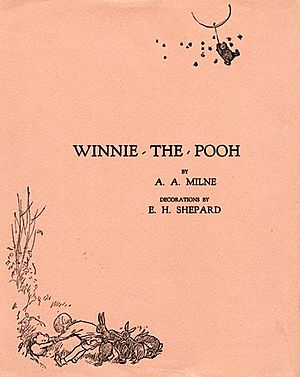Winnie-the-Pooh (book) facts for kids

First edition
|
|
| Author | A. A. Milne |
|---|---|
| Illustrator | E. H. Shepard |
| Country | United Kingdom |
| Genre | Short story collection, children's literature |
| Publisher | Methuen & Co. Ltd. (London) |
|
Publication date
|
14 October 1926 |
| Media type | Print (hardback & paperback) |
| Followed by | The House at Pooh Corner |
Winnie-the-Pooh is a super popular children's book from 1926. It's the very first collection of stories about the lovable Winnie-the-Pooh and his pals. The book was written by A. A. Milne and brought to life with amazing drawings by E. H. Shepard.
The stories follow the adventures of a friendly teddy bear named Winnie-the-Pooh. You'll also meet his best friends: Piglet, a tiny toy pig; Eeyore, a gloomy toy donkey; Owl, a wise live owl; and Rabbit, a busy live rabbit. Later in the book, you'll meet Kanga, a toy kangaroo, and her son Roo. The bouncy toy tiger, Tigger, shows up in the next book, The House at Pooh Corner.
In 2003, Winnie the Pooh was voted number 7 in a big survey by the BBC called The Big Read. This shows how much people love these classic tales!
Contents
What Happens in the Book?
The book is made up of ten fun chapters, each telling a new adventure.
Pooh's Honey Trouble
- Chapter 1: Pooh and the Bees: Winnie-the-Pooh really loves honey! When he runs out, he and Christopher Robin try to trick some bees into giving them theirs. Things don't quite go as planned!
Pooh Gets Stuck
- Chapter 2: Pooh Visits Rabbit: Pooh goes to visit Rabbit's house. He eats so much while he's there that he gets stuck in Rabbit's front door on his way out!
Hunting for Woozles
- Chapter 3: Pooh, Piglet, and the Woozle: Pooh and Piglet go on a "hunt." They follow more and more footprints around a group of trees. What do you think they're tracking?
Eeyore's Missing Tail
- Chapter 4: Eeyore Loses His Tail: Poor Eeyore loses his tail! Pooh sets out to find it. He notices something very interesting about Owl's bell-pull.
Heffalump Traps
- Chapter 5: Piglet Meets a Heffalump: Piglet and Pooh try to set a trap for a mysterious creature called a Heffalump. But they end up catching the wrong kind of animal!
Eeyore's Birthday Gifts
- Chapter 6: Eeyore's Birthday: Pooh feels sad that no one remembered Eeyore's birthday. So, he and Piglet try their very best to find him some presents.
New Friends in the Forest
- Chapter 7: Kanga and Roo Arrive: Rabbit tries to convince Pooh and Piglet to kidnap Baby Roo. He hopes this will make Kanga, the new kangaroo in the forest, leave.
The North Pole Expedition
- Chapter 8: Finding the North Pole: Christopher Robin leads all the animals in the forest on an exciting journey. Their mission is to find the North Pole in the Hundred Acre Wood!
Piglet and the Flood
- Chapter 9: Piglet Surrounded by Water: Piglet gets trapped in his home because of a big flood. He sends a message in a bottle, hoping someone will rescue him.
A Party for Pooh
- Chapter 10: Christopher Robin's Party: Christopher Robin throws a party for Pooh. It's a special celebration for helping to save Piglet during the flood!
Books in Other Languages
Winnie-the-Pooh has been translated into many different languages. One famous translation is into Latin! This Latin version, called Winnie ille Pu, came out in 1958.
In 1960, it became the first book not written in English to appear on the New York Times Best Seller List. It's also the only book ever in Latin to make that list! The book was also translated into Esperanto in 1972.
Pooh on Screen
The stories of Winnie-the-Pooh have been turned into cartoons and movies.
Disney's Pooh
In the 1960s, Disney got the rights to make Pooh cartoons. They used Milne's original stories for their animated film Winnie the Pooh and the Honey Tree. Disney also changed Pooh's look a bit, giving him his famous red shirt that was first created by Stephen Slesinger in the 1930s.
Russian Cartoons
Parts of the book were also made into three short animated films in Russia. These were directed by Fyodor Khitruk. They include Winnie-the-Pooh (based on chapter 1), Winnie-the-Pooh Pays a Visit (based on chapter 2), and Winnie-the-Pooh and a Busy Day (based on chapters 4 and 6).
More Pooh Adventures
After Winnie-the-Pooh, A. A. Milne wrote another book called The House at Pooh Corner.
Years later, new official Pooh books were written with the full support of A. A. Milne's family.
Return to the Hundred Acre Wood
Return to the Hundred Acre Wood by David Benedictus was the first new Pooh book after Milne's time. It brought back Pooh, Tigger, Piglet, and Eeyore. A new friend, Lottie the Otter, also joined them! The drawings were done by Mark Burgess.
The Best Bear in All The World
The Best Bear in All The World is the second official new Pooh book. It was published in 2016. Four different authors wrote four short stories for this book, one for each season: Winter, Spring, Summer, and Fall. Mark Burgess also illustrated this book.
Who Owns Pooh?
In 2001, Disney bought all the rights to the Winnie-the-Pooh characters from the people who managed Milne's estate. This deal gave Disney full control over the Pooh stories and characters.

